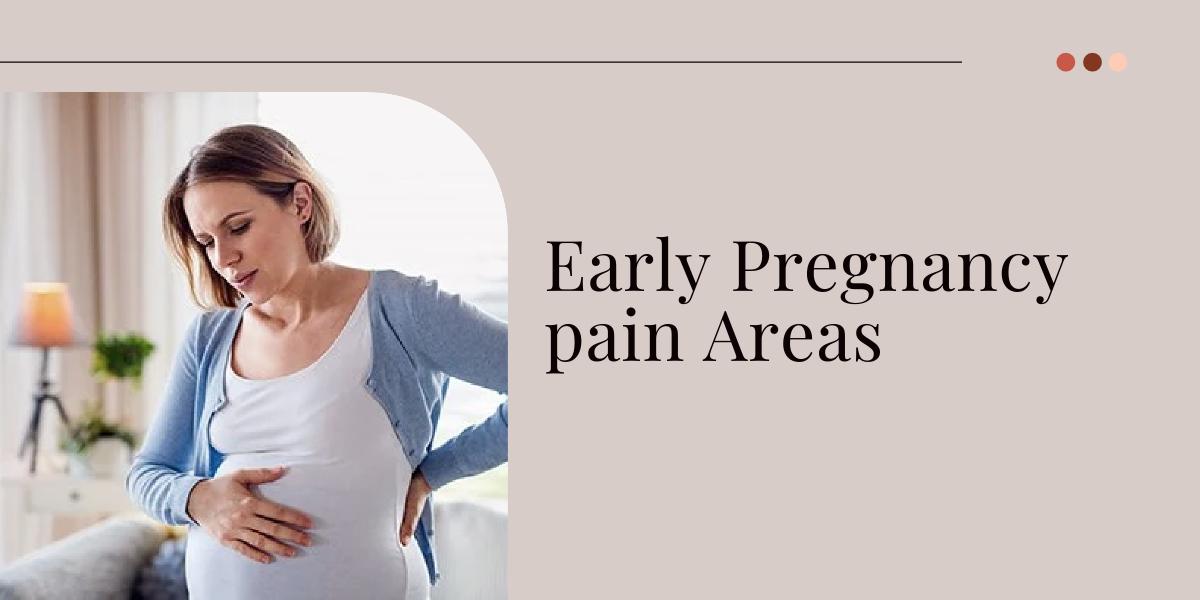In this article, we are going to know about early pregnancy pain areas.
Most pregnancies are healthy and result in a healthy baby’s happy delivery. Signing up for a thorough prenatal program with an obstetrician is your first and most crucial step. You will receive regular checks to ensure that everything is going well for you and your developing child, and if it is not, you will be referred for the necessary care. Each stage of your pregnancy, including labor, giving birth, and caring for and nursing a newborn, will be covered in detail, providing you and your spouse confidence-boosting knowledge. During Pregnancy, you may experience a variety of pains, some of which are temporary and others that last longer. Some may manifest in the first several weeks, while others may show up closer to the delivery date. So here are some lists of Early Pregnancy pain Areas.
Wrist Pain in Pregnancy:
You might be shocked to learn that carrying a baby might hurt your wrist. However, 35% of pregnant women experience wrist pain or weakness, typically in the third trimester. The carpal tunnel, which extends from your wrist to the base of your palm, is under additional strain due to fluid retention. Most likely, the pain will subside a few months after your child’s birth. Call your doctor if you have pain, tingling, or numbness in your hand or wrist, or if any weird feelings spread up your arm to your shoulder.
Uterus pain in Pregnancy:
You can feel slight uterine twinges or cramp in the early stages of Pregnancy. Additionally, you can experience pain in your back, pelvis, lower abdomen, or vagina. It might resemble cramps from a menstrual period. These small aches could be brought on by implantation, constipation, gas, the womb enlarging, and your ligaments stretching to make place for the baby or any other things. It is probably nothing to worry about if the discomfort is minor and goes away. But you should inform your doctor if you experience any pain coupled with spotting or severe bleeding. If you feel fainting, nausea, high temperature, chills, or dizziness with acute or persistent pain, seek immediate attention.
Even though it is probably not a cause for concern if the discomfort goes away on its own, you should nonetheless let your doctor know. Additionally, if you experience mild uterine pain while pregnant, you should inform your doctor. They can determine whether you can wait until your subsequent prenatal appointment or whether you need to be seen right away. Also, let your doctor know if you are bleeding or spotting while suffering uterine pain. These might be miscarriage symptoms. Your doctor can evaluate your symptoms and decide what to do next.
Round ligaments Pain:
Your uterus is held in place by muscles in your pelvis called the round ligaments. They stretch when your womb expands, especially in the second trimester, and may feel painful. The pain is typically limited to one side of the abdomen and might be severe or like a pulling sensation. Though it can come back when you laugh, rise, or stoop down, the discomfort should only last a few seconds or minutes. During Pregnancy, a woman’s body produces hormones that cause her ligaments to loosen and stretch. This aids the body’s adaptation to the developing infant. The circular ligaments and the uterus are stretched when a baby develops inside the womb. The round ligaments may spasm due to this training, resulting in discomfort. Pain in the round ligaments nearly always arises during Pregnancy. Rarely, though, might women who are not pregnant have pain in the round ligament. Endometriosis may be present when the uterine lining extends outside the uterus.
Round ligament discomfort can be reduced by:
- Resting
- Preventing quick movements
- Applying hot compresses
- Exercising gently or prenatal yoga
- Obtaining a pregnancy massage
If the pain is persistent or if you experience additional symptoms in addition to it, you should call your doctor.
Belly pain during Pregnancy:
Pregnancy frequently causes stomach discomfort or cramps. Although they typically are not a cause for concern, they could occasionally indicate something more serious that needs to be examined. If the pain is minor and goes away when you move, rest, poop, or breathe, there is usually nothing to worry about. However, if you are concerned and experiencing stomach pain, check with your healthcare provider. The majority of pregnancy cramps and stomach aches are normal. However, there are several signs you should be aware of because they can point to a more serious problem. Severe stomach cramps that linger for several hours and may or may not be accompanied by bleeding can indicate a placental abruption or a miscarriage.
This could indicate early labor, especially if you also experience:
- Any increase in vaginal discharge, whether it is a gradual drip, a burst of clear or pinkish fluid from the vagina, or both.
- Backache that is not typical of you.
- Cramping similar to severe period aches
- A sensation of pressure in the lower portion of your abdomen
Liver pain:
Numerous vital processes, such as separating nutrients and producing bile, which aids in digestion, are carried out by your liver. Several different liver conditions can manifest during Pregnancy. To receive the proper diagnosis, consult with your healthcare provider. The liver’s digestive enzyme is produced by your gallbladder, which is related to your liver. You may experience aching in your upper right abdomen, just below your ribs, as a result of gallstones and other liver-related issues. Typically, the pain is dull and nebulous and may be accompanied by back pain and darker urine. Additionally, you can have severe itching, which could be a sign of gallbladder issues.
Ovarian Torsion:
When the ovary twists inside the body, it may also twist the fallopian tube. Lower abdomen discomfort that is overwhelming, abrupt, severe, and sudden causes some women to vomit or lose consciousness. Typically, it only affects one side of the body, most frequently the right side. Ovarian torsion can be brought on by an ovarian cyst, although it can also develop suddenly. It typically occurs in weeks 6 to 14 in pregnant women. The ovary can occasionally twist back into place on its own, but it does not always happen. Ovarian torsion might permanently harm your fertility if it stops the ovary’s blood flow. To untwist your ovary and fallopian tube, surgery may be required. Although it usually is not, ovarian torsion can be lethal to Pregnancy in specific situations. However, it can be very uncomfortable, and surgery to fix it might impact your Pregnancy. Go right to the emergency room if you experience severe discomfort on one side.
Right lower quadrant pain:
The bottom right side of your abdomen, from the belly button down, is your right lower quadrant. Pregnancy-related right lower quadrant pain can have numerous reasons. The majority is unimportant, but if your pain is sharp, does not go away, or is accompanied by other symptoms, you should get medical attention. The same ailments that cause stomach pain in non-pregnant women might also cause it in pregnant women. The symphysis pubis, which connects the two bones at the front of your pelvis, is affected by pelvic girdle discomfort. During Pregnancy, this joint becomes lax, frequently as early as week 14. The symphysis pubis is typically where the hurt is noticed. However, it can also radiate to the RLQ.
Back pain during Pregnancy:
According to estimates, 50 and 80 percent of pregnant women have back pain. It might range from minor discomfort brought on by particular activities to severe discomfort that persists over time. About 10% of the time, the pain is so bad that it makes it difficult for pregnant women to work or engage in daily activities. Studies show that lower back discomfort can start as early as eight to twelve weeks into a pregnancy, although it often starts between the fifth and seventh months. Back discomfort is more likely to affect pregnant women with lower back issues, and it may start earlier in the Pregnancy.
Call your doctor to rule out any serious conditions if you feel numbness, tingling, or a sharp, shooting pain in your buttocks, legs, or feet. Numbness may be caused by compression of the sciatic nerve or other nerves that go from your spine to your lower body and pelvic region, even though the cause is typically not a more concerning issue, such as preterm labor. Women taking painkillers and thinking about getting pregnant should talk to their doctors about the advantages and disadvantages of the medication.
Pelvic pain:
While pregnant, some women experience pelvic pain. This condition is sometimes known as symphysis pubis dysfunction or pelvic girdle pain in pregnancy. PGP during Pregnancy is thought to have some effect on up to 1 in 5 expectant mothers, most frequently later in the Pregnancy. Although the actual cause of pelvic pain in some women is unknown, it is believed to be related to a number of factors, including previous pelvic injury, unequal movement of the pelvic joints, and the size or location of the baby. Inform your obstetrician if you experience any pain in your pelvic region. Obtain a recommendation for a physiotherapist with expertise in treating issues with the pelvic joint from a member of your maternity care team. Most of the time, these issues don’t go away until the baby is born, but treatment from a skilled professional can greatly reduce the symptoms while pregnant.
Final Thoughts:
With the help of the information above, you should now have a clear understanding of the early-pregnancy pain areas. Therefore, with this clear information, you may be aware of this type of pain and be prepared during your earlier Pregnancy.



